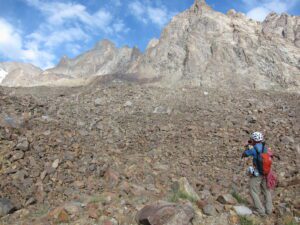Uncategorized
Climbing in the Pamirs, Tajikistan
Published
10 years agoon
First ascents and teaching locals mountain skills
By Corey LaForge Explore Big Sky Contributor
In the pre-dawn darkness of a narrow Dushanbe alley, our headlamps illuminated the words “frozen chicken,” printed on the boxes in the roof rack.
We were concerned. There were four of us with expedition gear for three weeks of climbing in the peaks of the Pamir – we would need all the space on that luggage rack and then some. Also it was August, and we had a 350-mile drive on marginal roads across the high steppe of Tajikistan. It was questionable if we could make this journey without going bad, but frozen chicken most certainly would not have.
Luckily, those words didn’t reveal the actual contents – they were just boxes of other goods, like when your aunt sends a Christmas sweater in a PBR 12-pack box.
Our expedition leader Bo White managed the situation with the driver, while Peter Anderson, Jim Donini and I loaded huge duffels atop and around the chicken boxes and into the passenger areas. Then we began the drive east to one of the world’s highest and most remote mountain ranges, where we would teach students from the fledgling Pamir Alpine Club the basics of wilderness first aid and alpinism, and attempt to scratch the surface of an untapped wealth of alpine climbing objectives.


Khorog, population 30,000, is similar in latitude and elevation to the high desert of southern Utah or Colorado. The town and surrounding villages scratch out subsistence only where they can irrigate. For me, seeing apple, poplar and box elder trees, sagebrush, sunflowers, and gardens with tomatoes, cucumbers and squash made this remote place feel remarkably like home in the Rocky Mountains.
The Pamiri people welcomed us with warm hospitality, compounding that feeling. We stayed with a local family who rents out their house within the gates of the city park, the hub of the town’s activities and a cherished community resource.
The park’s green grass and lofty poplars provided shade as Peter – director of the Missoula-based Sentinel Outdoor Institute – conducted scenarios during a First Aid Class.
Sentinel specializes in outdoor medical training and education in underserved locations around the world, and with Peter’s leadership, we worked with the Pamir Eco-Cultural Tourism Association and the University of Central Asia to conduct medical and climbing courses for the Pamir Alpine Club.


Skeptical the students would heed my warnings about the importance of proper preparation – let alone manage the five-mile hike into the mountains and camping at elevation – I left the problem of ensuring everyone came prepared up to club president Sharaf Saidrakhmonov. He silenced the joking and translated the plan in Russian, seeming to take the commanding tone of a military leader.
His goal was the same as ours: to teach the club’s members to capitalize on their most abundant resource: mountains. In every direction from Khorog, the Pamirs rise to heights above 7,000 meters, or 22,900 feet, and many of them are still unexplored by climbers. Having been there on a previous expedition, Jim and Bo had already chosen a venue about 20 minutes drive and a couple of hours hike from town for instructing the students.
With good camping, a nearby training cliff, and mountains all around, it was the perfect spot.


We found blocky gneiss slabs, flakes and cracks, and 1,000 feet of fun, moderate climbing to a previously unclimbed summit at around 15,000 feet.
We were pleased with our climb, but the fear of an unknown descent route limited the celebration to a high-five. From the knife-edged summit, we cast our ropes off of the opposite side of the peak, and began rappelling down a face and gulley we had never seen. Until we were back on the ground, discussion was limited to tense, short exchanges. We were deep in the heart Central Asia, where there is little chance of rescue if anything goes wrong.
In the meantime, Bo and Jim established several 80- to 100-foot rock climbs at the base of an 800-foot face near camp, to serve as the classroom. There, students would learn climbing skills on a cliff surrounded by peaks named for the ancient Persian book of mythology, The Shahnameh.
All the peaks in the valley that Bo and his teammates had climbed on previous expeditions were also named for the 1,000-year-old book, and the mountain we climbed would come to be known as Rahksh, for the stallion belonging to the protagonist Rustam.
The students who joined us here the next day – many camping and climbing for the first time – had a chance to look at their home in a new light.
Despite my initial misgivings, our 12 students trudged into camp in the rain hunched under full packs exactly at the planned time. The seven young men and five young women arrived tired, but in good spirits, and had done their best to come prepared with some close approximation of everything I’d instructed them to bring.
Amazingly, these students, who ranged from 18-25 years old, proved hardier than their in-town personas may have indicated. Perhaps growing up in the marginalized outer reaches of the former Soviet Union had made them accustomed to the notion of making due?
There wasn’t a single complaint about cold rainy conditions, lousy food or camp chores, all of which can make seasoned mountaineers go bad on occasion. The students quickly took to the tasks and joys of life in the mountains together – cooking on a camp stove, pitching tents and laughing while huddling around hot drinks to tell stories about the day. Despite the language and cultural barriers, there was a camaraderie and teamwork among them that didn’t need to be taught, and was a pleasure to be a part of.
Safia, Sharaf and their group slept in tents and donned harnesses and helmets for the first time during the two days of the course, but by the end it was clear it would not be their last. When we retreated back to town early the following day due to bad weather, they protested, not wanting to cut the course short. Returning to town meant a return to normal life, where learning to climb mountains is a farfetched notion.
While we did all we came to do in Tajikistan – teach first aid and climbing, and establish new routes – our accomplishments felt limited. The Pamir Alpine Club still had so much to learn, and we had seen many huge peaks that were just a little too far away for the time we had.
In the end, we returned home along the rugged roads and around-the-world flights, knowing we would someday return to work with our new friends, and to dig just a little deeper into the treasure troves of the Pamir.
Corey LaForge grew up in Bozeman and attended Montana State University, where he studied Mechanical Engineering Technology. He now lives in Salt Lake City and works as a Quality Assurance Manager for Black Diamond, Inc., a job that brings him to locations all over the world. This trip took place in summer 2013, and was supported in part by the Aga Khan Development Network, a Swiss nonprofit.
Megan Paulson is the Co-Founder and Chief Operating Officer of Outlaw Partners.


Upcoming Events
april, 2024
Event Type :
All
All
Arts
Education
Music
Other
Sports
Event Details
Children turning 5 on or before 9/10/2024:
more
Event Details
Children turning 5 on or before
9/10/2024: Kindergarten
enrollment for the 2024-2025 school year can be completed by following the
registration process now.
Children
born on or after September 11, 2019: 4K enrollment is now open for
families that have a 4-year-old they would like to enroll in our program for
the 2023-2024 school year. Please complete the 4K Interest Form to
express your interest. Completing this form does not guarantee enrollment into
the 4K program. Enrollment is capped at twenty 4-year-olds currently
residing within Big Sky School District boundary full time and will be
determined by birth date in calendar order of those born on or after September
11, 2018. Interest form closes on May 30th.
Enrollment now is critical for fall preparations. Thank you!
Time
February 26 (Monday) - April 21 (Sunday)
Event Details
Saturday, March 23rd 6:00-8:00pm We will combine the heart-opening powers of cacao with the transcendental powers of breathwork and sound. Together, these practices will give us the opportunity for a deep
more
Event Details
Saturday, March 23rd 6:00-8:00pm
Time
March 23 (Saturday) 6:00 pm - April 23 (Tuesday) 8:00 pm
Location
Santosha Wellness Center
169 Snowy Mountain Circle
Event Details
We all are familiar with using a limited palette, but do you use one? Do you know how to use a
more
Event Details
We all are familiar with using a limited palette, but do you use one? Do you know how to use a limited palette to create different color combinations? Are you tired of carrying around 15-20 different tubes when you paint plein air? Have you ever wanted to create a certain “mood” in a painting but failed? Do you create a lot of mud? Do you struggle to achieve color harmony? All these problems are addressed in John’s workbook in clear and concise language!
Based on the bestselling “Limited Palatte, Unlimited Color” workbook written by John Pototschnik, the workshop is run by Maggie Shane and Annie McCoy, accomplished landscape (acrylic) and plein air (oil) artists,exhibitors at the Big Sky Artists’ Studio & Gallery and members of the Big Sky Artists Collective.
Each student will receive a copy of “Limited Palette, Unlimited Color” to keep and take home to continue your limited palette journey. We will show you how to use the color wheel and mix your own clean mixtures to successfully create a mood for your paintings.
Each day, we will create a different limited palette color chart and paint a version of a simple landscape using John’s directives. You will then be able to go home and paint more schemes using the book for guidance.
Workshop is open to painters (oil or acrylic) of any level although students must have some basic knowledge of the medium he or she uses. Students will be provided the book ($92 value), color wheel, value scale and canvas papers to complete the daily exercises.
Sundays, April 14, 21 and 28, 2024
Noon until 6PM.
$170.
Time
14 (Sunday) 12:00 pm - 28 (Sunday) 6:00 pm
Event Details
Come join us at Cowboy Coffee as we celebrate a fun night of drinks, games, and meeting others within the community. This event is from 6-8 and all are welcome
Event Details
Come join us at Cowboy Coffee as we celebrate a fun night of drinks, games, and meeting others within the community. This event is from 6-8 and all are welcome to come, if you don’t know who to bring come alone this is a great mixer event! This is an event hosted by Big Sky OUT as we work to provide queer safe spaces throughout the community.
Time
(Sunday) 6:00 pm - 8:00 pm
Location
Cowboy Coffee
25 Town Center Ave. Big Sky, MT 59716










